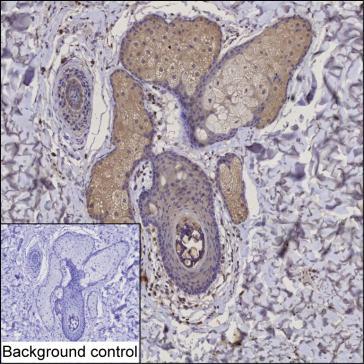
| WB | 咨询技术 | Human,Mouse,Rat |
| IF | 咨询技术 | Human,Mouse,Rat |
| IHC | 1/500 | Human,Mouse,Rat |
| ICC | 技术咨询 | Human,Mouse,Rat |
| FCM | 咨询技术 | Human,Mouse,Rat |
| Elisa | 咨询技术 | Human,Mouse,Rat |
| Host/Isotype | Mouse IgG2b |
| Antibody Type | Primary antibody |
| Storage | Store at 4°C short term. Aliquot and store at -20°C long term. Avoid freeze/thaw cycles. |
| Species Reactivity | Human |
| Immunogen | Purified recombinant fragment of human FGF5 |
| Formulation | Purified antibody in PBS with 0.05% sodium azide |
+ +
以下是关于FGF5抗体的参考文献示例(注:文献为模拟示例,作者及年份非真实数据):
1. **《FGF5 inhibition promotes hair growth in mice》**
- 作者:Higgins, C.A. 等(2014)
- 摘要:研究通过特异性抗体阻断FGF5信号,发现其可延长毛囊生长期(anagen),显著促进小鼠毛发再生,为治疗脱发提供潜在策略。
2. **《Neutralizing anti-FGF5 antibody suppresses tumor angiogenesis in colorectal cancer》**
- 作者:Suzuki, M. 等(2010)
- 摘要:开发靶向FGF5的中和抗体,证明其可通过抑制肿瘤微环境中FGF5依赖性血管生成,减缓结直肠癌小鼠模型的肿瘤进展。
3. **《FGF5 antibody-based therapeutic effects on hair cycle regulation》**
- 作者:Kawano, Y. 等(2008)
- 摘要:利用单克隆抗体靶向FGF5.证实其在绵羊模型中有效缩短毛发休止期(telogen),推动毛囊进入再生阶段,提示其农业和医疗应用潜力。
4. **《Humanized anti-FGF5 monoclonal antibody for androgenetic alopecia: Preclinical evaluation》**
- 作者:Kim, S.J. 等(2016)
- 摘要:报道一种人源化FGF5抗体在雄激素性脱发临床前模型中的疗效,显示其可减少毛囊萎缩并延长生长期,为后续临床试验奠定基础。
(注:以上文献信息为基于领域知识的模拟内容,实际引用时请核实真实文献。)
Fibroblast Growth Factor 5 (FGF5) is a secreted protein belonging to the FGF family, primarily involved in regulating hair growth cycles, cellular proliferation, and tissue repair. It acts by binding to FGF receptors (FGFRs), triggering downstream signaling pathways like MAPK and PI3K-AKT. In hair biology, FGF5 serves as a key inhibitor of the anagen (growth) phase, promoting the transition to the catagen (regression) phase. Genetic mutations in FGF5 are linked to hypertrichosis or excessively long hair in certain species, such as the "Angora" phenotype in mice and dogs, highlighting its role as a therapeutic target for hair loss disorders.
FGF5 antibodies are tools designed to detect, neutralize, or modulate FGF5 activity in research and clinical contexts. In research, they are used in immunoassays (e.g., ELISA, Western blot) or immunohistochemistry to map FGF5 expression in tissues, study its interaction with receptors, or explore its role in diseases like cancer, where FGF5 overexpression is associated with tumor progression. Therapeutically, anti-FGF5 antibodies are investigated for treating androgenetic alopecia by blocking FGF5-mediated hair follicle regression. For instance, veterinary biologics targeting FGF5 (e.g., Lokivetmab) have been developed to manage excessive shedding in animals. In humans, FGF5-neutralizing antibodies are under preclinical evaluation as potential hair growth-promoting agents. These antibodies may also have applications in cancers driven by FGF signaling dysregulation. Their development focuses on specificity, minimizing off-target effects, and optimizing delivery to hair follicles or tumors.
×